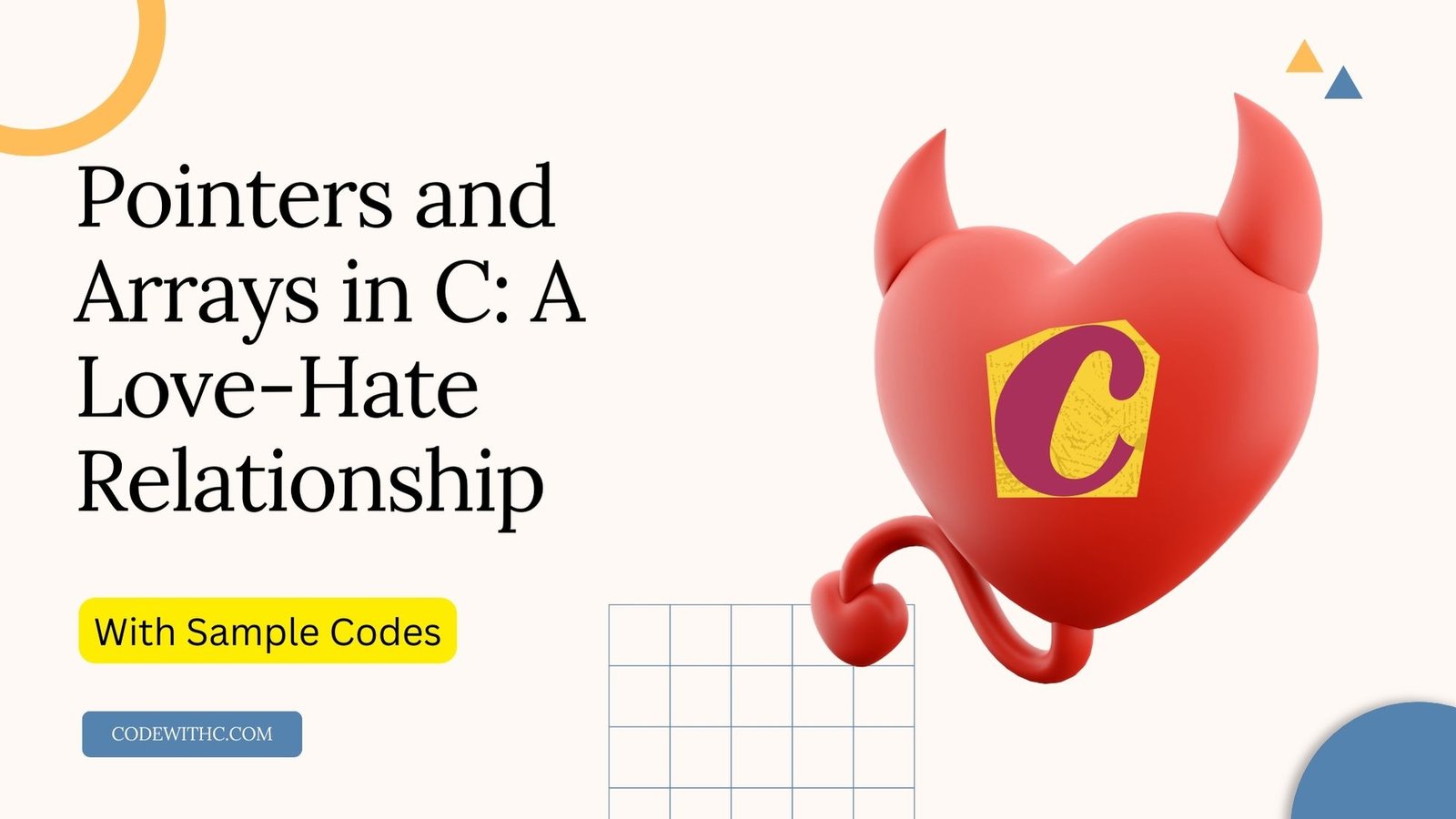The Eternal Tug-of-War Between Pointers and Arrays
Hey, you awesome code warriors! ? Guess what? Today we’re diving into a topic that’s as mind-boggling as it’s intriguing: the relationship between pointers and arrays in C programming. I mean, come on, who hasn’t felt bamboozled by pointers at some point? ?♀️ And then you realize you’ve got arrays in the mix too. It’s like watching a Bollywood drama unfold right in your IDE!
You might think arrays are straightforward, right? Just a bunch of same-type elements sitting next to each other, all neat and orderly. But then enters pointers, the rebels of the C programming world, and suddenly you’re like, “Wait, what’s happening?” ? It’s a classic love-hate saga. Sometimes they work together like a dream, creating code that’s elegant and efficient. Other times? You’re stuck in debugging hell, cursing whoever decided to put pointers and arrays together in the first place. Ah, the drama! ?
But guess what? They’re more like star-crossed lovers, each filling in for what the other lacks. The array provides structure, the pointer offers flexibility, and together they create magic—or havoc, depending on how well you understand them. ? So, in today’s jaw-dropping episode of “Coding with a Twist,” we’re going to untangle this complicated relationship. We’ll delve into how these two entities interact, why you’d want to mix them together, and how to do it without pulling your hair out.
Hold onto your chai or coffee, pals, because we’re about to take a roller coaster ride through the land of pointers and arrays. By the end of this blog, you’ll either be chanting ‘Pointers Zindabad!’ (long live pointers) or… well, let’s not get into the darker possibilities. ?
The Basic Building Blocks: Understanding Pointers and Arrays
What’s a Pointer Anyway?
So first things first, what are these two enigmatic entities? An array is like that organized friend who loves to keep things in line, literally. It’s a collection of elements of the same data type stored in contiguous memory locations.
The Array Lowdown
On the flip side, a pointer is more like that wild friend who loves freedom; it’s a variable that stores the address of another variable. Yep, it’s kinda like an address book for your variables.
Why All the Fuss: The Importance of Pointers in Arrays
The Syntactic Sugar Coating
If you’ve tinkered around with C, you probably know that arrays and pointers are like peas in a pod; they’re often used interchangeably. That’s coz’ an array name is essentially a constant pointer. And it’s not just syntactic sugar, folks! Using pointers makes your code more efficient, especially when you’re working with large arrays or multi-dimensional arrays.
What’s in a Name: The Array Name as a Constant Pointer
I know, I know, it sounds like a riddle! But listen, the name of an array is basically the address of the first element. So when you declare an array like int arr[5];, what you’re really saying is int *const arr;. Mind-blowing, right?
The Great Swap: Array Indexing vs Pointer Arithmetic
A Code Snippet for The Brave
Array indexing is cool, but pointer arithmetic is cooler. Why? Coz’ it’s faster. If you want to access the 5th element of an array, you can either do arr[4] or *(arr + 4). The latter method skips the multiplication operation, making it faster. Let’s take a look at a sample code snippet to understand this better.
The Love Triangle: Arrays, Pointers, and Functions
Why Functions Love Pointers More
Adding another layer of complexity, let’s talk about how pointers and arrays co-exist when you’re dealing with functions. Sending an array as an argument to a function can be quite a headache, but pointers make it a breeze. Pointers allow for dynamic memory allocation, which is a godsend when you’re working with arrays of unpredictable sizes.
Large Sample Code: Dynamic Memory Allocation for 2D Arrays Using Pointers in C
#include <stdio.h>
#include <stdlib.h>
int main() {
int rows, cols;
int **arr;
int i, j, sum = 0;
printf("Enter the number of rows: ");
scanf("%d", &rows);
printf("Enter the number of columns: ");
scanf("%d", &cols);
arr = (int **)malloc(rows * sizeof(int *));
for(i = 0; i < rows; i++) {
arr[i] = (int *)malloc(cols * sizeof(int));
}
printf("Enter the elements of the 2D array:\n");
for(i = 0; i < rows; i++) {
for(j = 0; j < cols; j++) {
scanf("%d", &arr[i][j]);
sum += arr[i][j];
}
}
printf("The 2D array is:\n");
for(i = 0; i < rows; i++) {
for(j = 0; j < cols; j++) {
printf("%d\t", arr[i][j]);
}
printf("\n");
}
printf("The sum of all elements is: %d\n", sum);
for(i = 0; i < rows; i++) {
free(arr[i]);
}
free(arr);
return 0;
}
Code Explanation ?
- Dynamic Memory Allocation: We use
malloc()to dynamically allocate memory for a 2D array. This is where pointers become super handy, giving us the flexibility we need. - Nested Loops for Input and Output: After allocating the memory, nested loops are used to get the array elements and to print them. Along the way, we’re calculating the sum of all elements because why not?
- Memory Deallocation: Don’t forget to free the allocated memory at the end. We use
free()to avoid memory leaks.
Expected Output ?
Let’s say you entered 2 rows and 2 columns, and the elements as 1, 2, 3, and 4. The output will be:
The 2D array is:
1 2
3 4
The sum of all elements is: 10
And there you have it! Dynamic memory allocation for 2D arrays using pointers. Pretty nifty, right? ??
Conclusion: It’s Complicated, But It’s Worth It
A Final Word to The Wise
You’ve reached the end, my code warriors! ? By now, I hope you’ve seen that pointers and arrays are like PB&J; they might seem odd at first, but they’re actually perfect together. Yes, it can be overwhelming, but once you get the hang of it, you’ll see how they complement each other in making your code efficient and dynamic.
The beautiful thing about programming, and life in general, is that the more you struggle, the more you learn. Like, the day I fully grasped pointers was the day I felt invincible, you know? ?♀️ So don’t get disheartened if you still feel like you’re stuck in a melodramatic soap opera with pointers and arrays. Just keep grinding, keep experimenting, and keep asking “Why?” and “What if?” Trust me, the ‘aha’ moment is worth the struggle.
In the world of coding, you’re never done learning. There will always be another challenge, another problem that makes you want to hurl your laptop out of the window. But remember, that’s how you grow. So, keep at it, and soon you’ll be writing code that’s as poetic as it is functional. And hey, if you ever feel stuck, just remember: even the most complex love stories have a happy ending. ?
Thank you for sticking around, you fabulous humans. Until next time, keep coding, keep exploring, and keep falling in and out of love with pointers and arrays. ??







